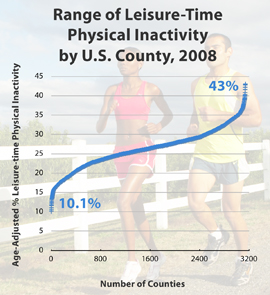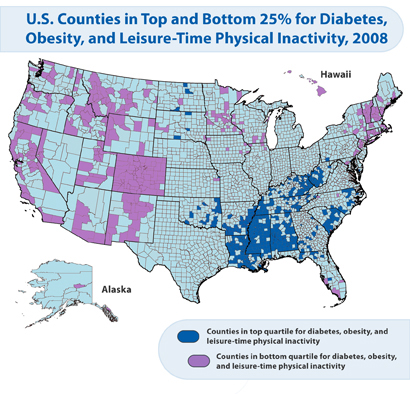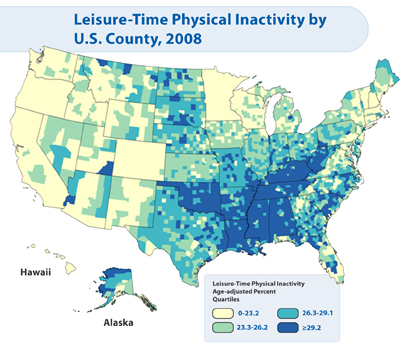Physical Inactivity Estimates, by County
Staying active during leisure time can reduce your risk of obesity, type 2 diabetes and related diseases.
 Physical inactivity can lead to obesity and type 2 diabetes. Physical activity can help control weight, reduce the risk of heart disease and some cancers, strengthen bones and muscles, and improve mental health.
Physical inactivity can lead to obesity and type 2 diabetes. Physical activity can help control weight, reduce the risk of heart disease and some cancers, strengthen bones and muscles, and improve mental health.
New estimates of physical inactivity during leisure time are available from CDC, and include estimates for all counties in the United States. Estimates of age-adjusted rates of leisure-time physical inactivity ranged from 10.1% to 43.0%.
Regions with high rates of leisure-time physical inactivity are the South and Appalachia, which also have high rates of diagnosed diabetes and obesity. States where residents are the least likely to be physically active in their free time are Alabama, Kentucky, Louisiana, Mississippi, Oklahoma and Tennessee. In those states, physical inactivity rates are 29.2% or greater for more than 70% of counties.
Areas where residents are most likely to be active when not at work are the West Coast, Colorado, Minnesota and parts of the Northeast. States where physical inactivity rates are 23.2% or lower in more than 70% of counties are California, Colorado, Hawaii, Minnesota, Oregon, Vermont, and Washington.
The estimates help identify counties with high estimated numbers and percentages of people who are not physically active in their leisure time, and supplement existing county-level estimates for obesity and diagnosed diabetes.
Combining county level estimates for leisure-time physical inactivity, diagnosed diabetes, and obesity for 2008 shows that counties with high levels of all three variables are concentrated in the South and Appalachia. Some isolated counties in North Dakota, Pennsylvania and South Dakota also have high levels of diabetes, obesity and leisure-time physical inactivity. Counties with low levels of all three variables are concentrated in the Northeast and West. Some isolated counties in the South, in Florida, North Carolina and South Carolina, also have low levels of diabetes, obesity and leisure-time physical inactivity.
The 2008 estimates were modeled from the Behavioral Risk Factor Surveillance System (BRFSS), which uses self-reported data from state-based adult telephone surveys, and 2007 census information. Estimates of leisure-time physical inactivity for 2004-2007 also are available.
Physical inactivity and obesity are two of several factors linked to type 2 diabetes. Where people live, how much money they earn, their culture and their family history also influence disease rates. Some population groups also are at higher risk, including a number of racial and ethnic minorities. Groups at higher risk for the disease include African-Americans, Hispanics, American Indians/Alaska Natives, and some Asian-Americans and Pacific Islanders.
The Diabetes Prevention Program clinical trial, led by the National Institutes of Health, has shown that getting at least 150 minutes per week of moderate physical activity, such as brisk walking, and losing 5% to 7% of body weight can reduce the risk of developing type 2 diabetes by 58% in people at higher risk of the disease.


More Information
- County-Level Estimates of Diagnosed Diabetes, Leisure-Time Physical Inactivity and Obesity, 2004-2008
Search by county for estimates of diagnosed diabetes, leisure-time physical inactivity and obesity. Download prevalence maps and data spreadsheets for use in grant applications, policy briefs, educational and media resources. - CDC's Division of Diabetes Translation
Research and resources, including data and trends, publications and information on preventing type 2 diabetes. - CDC's Division of Nutrition, Physical Activity and Obesity
Resources for reaching a healthy weight and staying active, including a body mass index calculator for adults. - 2008 Physical Activity Guidelines for Americans
Recommendations for the types and amounts of physical activity that offer substantial health benefits. - Physical Activity
Resources for consumers and health professionals about staying active. - Physical Activity for Everyone
How much physical activity do you need? Physical activity guidelines for children, adults, and older adults. - Physical Activity for a Healthy Weight
Physical activity is important for good health, and it's especially important if you're trying to lose weight or to maintain a healthy weight. - National Diabetes Education Program
Information for people with diabetes, those at risk of the disease, health care professionals, community organizations and schools, from a partnership of CDC and the National Institutes of Health. - Native Diabetes Wellness Program
Resources on preventing type 2 diabetes and promoting health in Indian Country. - Diabetes Risk Test
- Adult BMI Calculator
- Finding a Balance [PODCAST - 4:39 minutes]
- Blood Sugar & Fears [PODCAST - 4:29 minutes]
- Preventing type 2 diabetes [PODCAST - 2:12 minutes]
- Deterring diabetes [PODCAST - 4:33 minutes]
- The obesity epidemic: What can be done? [PODCAST - 1:21 minutes]
- Stay physically active ecards
- Prevent type 2 diabetes

Get email updates
To receive email updates about this page, enter your email address:
Contact Us:
- Centers for Disease Control and Prevention
1600 Clifton Rd
Atlanta, GA 30333 - 800-CDC-INFO
(800-232-4636)
TTY: (888) 232-6348 - Contact CDC-INFO



